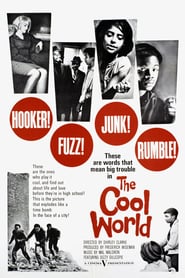
For decades, racial segregation and economic depredation drove Black America into poverty ridden ghettoized neighborhoods throughout the United States. One of the better known, of these ghettoes is Harlem, situated in the northern section of the affluent borough of Manhattan. Female Jewish American director, Shirley Clarke was a resident in the more hip and artsy areas of Manhattan. In the early 60’s she became fascinated with the lives and degrading situation of black America in the inner cities. Her film, “The Cool World”, is one of the greatest socially conscience films ever made concerning this theme. The movie’s story is simple and the way Clarke chose to film the plot development while confusing at times, results in bringing the city to life. The main protagonist is Duke, who is a typical 15 year old fatherless boy in Harlem, who’s only sense of purpose revolves around belonging to a youth gang called the Royal Pythons. Duke comes to the conclusion that he needs to gain the respect of being the leader of his gang and in order to do this he needs to purchase a gun. The local mafia connected gangster, Priest (Carl lee, who was one of the only professional actors in the film and Clarke’s lover), is willing to sell Duke a gun for a cut rate price of $50. For Duke that is a large sum of money and his side business of selling joints on the street would take him to long to make the $50. He will attempt other methods at getting the money from extortion to thievery. By the end of the film I realized that I was witnessing his development from sweet boyhood to hardened criminal. This extremely low budget film is made with jittery hand held cameras on location in Harlem. The bad production values made following the character’s dialogue and action sometimes difficult. The look and feel of the movies is very similar to Cassavetes’, “Shadows”, as like that film the script called for a lot of improvisation on the part of the cast. “The Cool World evokes a striking feel for its urban backdrop. The city comes alive in the gritty realistic camera that Clarke uses. The movie boasts a superb soundtrack from Dizzy Gillespie and his quintet. Upbeat and Somber the jazzy score relates to the characters and Clarkes direction gave me the feeling that the characters were at times walking and moving to the beat of the music. This is a style that would later be used in the Blaxploitation genre of the early 70s. Harlem of the early 60’s was a grim and hopeless environment with its drab architecture, crowded apartments and screams of injustice. Clarke’s probing documentary style camera expertly conveys the feel and pulse of the neighborhood. The movie opens at an outside rally from a minister, spewing hate for the white devil. This opening to me seemed like the start of negative propaganda, which by the movie’s end seemed more than appropriate when realizing the reality of the lives being portrayed. Black slavery was an ethnic catastrophe beyond understanding and was followed by a segregation policy which disallowed any true healing to take place within the African-American community. By understanding this truism, the film gives no signal for hope or desires but rather shows the reality of life in the ghetto as it existed in 1963. Schlesinger’s, “Midnight Cowboy”, Scorsese’s, “Mean Street” and Lumet’s, “Serpico”, owe a great debt to this low budget tour de force movie.

